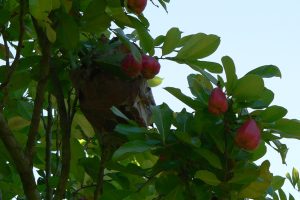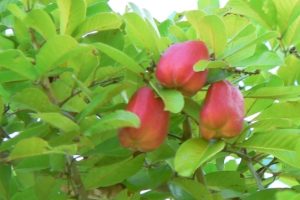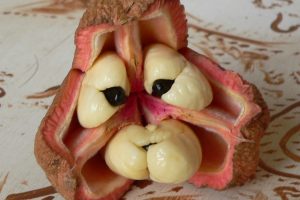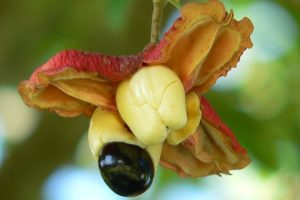Blighia sapida
Ackee, akee
Origin
Native to tropical West Africa; subsequently taken to the neotropics and then becoming pantropical. It is Jamaica’s national fruit.
Climate
It grows in tropical climates up to 1000m and in warm sub-tropical regions. When mature it can withstand limited drought and frost conditions, although fruit production may be affected. Salt spray will damage young leaves and flowers, and optimal temperature and precipitation ranges are 20-27°C and 700-2500mm pa.
Plant Description
An evergreen rarely deciduous tree with smooth grey bark, 6-12m high and plagiotropic growth producing a dense crown. The alternate paripinnate leaves on a short petiole have 5-8 pairs of oblong-obovate entire opposite leaflets, 19-18 X 7cm, an acute apex and are shiny green on the upper side and dull underneath.
Relatives
Ackee belongs in the Sapindaceae family which includes about 140 genera and 1900 species. Close relatives grown for their fruit include litchi, longan, rambutan, pitomba and pulasan.
Soils
It grows best in fertile well-drained light loams but will tolerate stony conditions, slightly alkaline limestone sands, or deep clay soils without an impermeable layer. Optimal soil pH is 5.5-7.5.
Propagation
This is normally by seeds which are recalcitrant. Seedlings are heterozygous and not true to type in tree form, size, shape of capsules, quality of fruit and yield. Fresh seeds will germinate quickly and good success rates are achieved if seeds are first sterilised and then scarified to hasten imbibition. Seedling growth is initially slow, maybe growing to only 20cm high in the first 3-4 months. Cuttings are the best means of vegetative propagation and will maintain desired characteristics and shorten the juvenility period, with best results obtained using 3500ppm indole-3 butyric acid (IBA) rooting hormone.
Cultivars
Many trees have been selected that produce desirable fruit, but there are no named varieties other than two broad categories depending on the aril – butter soft yellow and hard cream coloured. In the first the shape is lost with cooking, whereas in the second it is maintained. Cross-pollination between these two types has resulted in a range of trees with intermediate fruiting properties. Selection rather than targeted breeding studies has resulted in the genetic diversity of cultivated plants being only marginally less than those in the wild state.
Flowering and Pollination
The axillary inflorescences are racemes, 4-15cm long. Flowers are falsely polygamous–dioecious (functionally unisexual).
The relative proportion of each type seems to vary depending on build-up of reserves in individual branches. The fragrant pendent pentamerous flowers are 5cm long with light green sepals and white-cream petals, 3-8 stamens with free filaments and a 3 sometimes 4-5 carpelllate superior ovary containing a single ovule per carpel. In the sub-tropics flowering may be induced by cool temperatures with bloom during spring, but in the tropics they can flower continuously. Bees are the main insect pollinators, with some contribution by wind.
Cultivation
Full sunlight is preferred once established, and minimal attention is generally required. When young, the surrounding areas should be kept weed free. NPK (eg 10:6:10) with trace elements should be applied every 1-2 months when young, and commensurately bigger yearly applications should be applied at less frequent intervals with growth. As usual, mulching is beneficial.
Wind Tolerance
Strong winds can cause defoliation and desiccation.
Pruning
A vase-shaped scaffold of main branches should be developed when young. Pruning thereafter should mainly aim to keep size below 5m for ease of management & to minimise any possible wind damage.
The Fruit
The pyriform fleshy fruit, 70-200g, is a trilocular (sometimes 1-5) dehiscent ovoid capsule, 7-10cm long. The leathery green skin turns yellow-red at maturity and splits lengthwise when ripe to reveal yellow or cream-coloured waxy arils (strictly arillodes), 3-4 X 2-3cm, each partially enclosing a shiny black ovoid seed. Edible arils represent about 25% of the whole fruit weight and should only be eaten when the capsule opens naturally on the tree. Commercial growers may pick mature fruit, but they’re rejected if not opened within 3 days. The seeds are toxic and not eaten, and the pink raphe in the groove between aril lobes should also be removed. Most of the photosynthate energy stored in the fruit (aril) is in the form of lipids, similar to avocados and olives; healthy unsaturated fatty acids predominate. Ackee is a good source of Fe, Mg and vitamin C. Many Sapindaceae fruits, including ackee, contain the anti-nutrients, hypoglycin A & B (HA and HB resp). HA is more potent than HB and is found at highest concentrations in the arils, while HB is mainly in the seeds. When properly ripened (usually on the tree), the level of HA decreases to barely detectable levels – much less than the 100ppm limit the US FDA has set for fruit importation. If desired, any HA (which is water soluble) remaining in ripe arils can be further reduced by boiling and then discarding the water.
Fruit Production and Harvesting
Fruit production may commence within 2-3 years from seed, less when propagated vegetatively, and full production can be expected within 7 years. Fruit set is normally low (6%), even less with adverse weather, and within the first three weeks about half of these fruitlets will abscise. In sub-tropical climates the main harvest period is summer, but in the tropics there may be three or more crops per year. Fruit take 50-60 days to mature and harvest is staged, a positive feature for home-growers. Yields of well-managed trees can range from 200 to more than 2000 fruit per year, and arils can be kept in good condition for more than a week at 5°C.
Fruit Uses
Arils are eaten fresh or mainly after boiling and frying. Many people describe the fried product as delicious, with a taste and texture similar to scrambled eggs. The biggest concern about ackee concerns the anti-nutrient hypoglycin A, but if fruit are correctly handled and eaten this is not an issue. There have been reports of fatalities following consumption, mainly by malnourished children in developing countries who inadvertently eat too much unripe fruit and skip normal meals. This has resulted in unnecessary avoidance of a tasty, healthy and easily-grown fruit, given when they’re consumed in the recommended fashion any such risks are vanishingly small. To place this issue in context, deaths have also been reported in children in developing countries with hypoglycin A in litchi, but again when eaten appropriately, risk is almost non-existent and a delicious fruit can be enjoyed.
Pests and Diseases
Generally pest & disease free. There are overseas reports of problems with galls, mealy bugs and tropical fruit flies.
Comments
This attractive tree can probably be justified in your garden on looks alone, but it does more than that by producing good yields of a delicious fruit. Only a single tree is needed as it’s self-fertile, and management effort is minimal. It would be wise to plant your tree out of reach of passing children who may unknowingly take and eat fruit that is not ripe.



